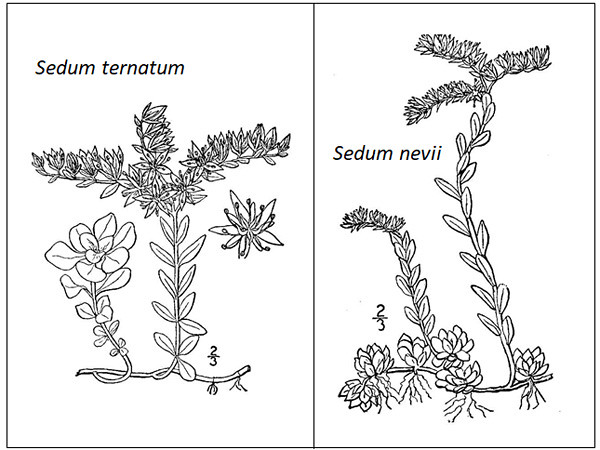White-flowered stonecrops of eastern North America
If you trust iNat's ID suggestions, then there's only one white-flowered stonecrop in the eastern US, Sedum ternatum. However, as anyone familiar with the pitfalls of computer suggestions might guess already, there are actually more than that. One in particular, Sedum glaucophyllum, is frequently misidentified as S. ternatum but tantalizingly close to having enough observations to be included in the next computer vision model. This post is intended to raise awareness of its existence and provide a comparison and guidance how to tell the two species apart.
I first encountered S. glaucophyllum on iNat while reviewing observations for S. ternatum and noticing different leaf arrangements than the plants I was familiar with. Almost at the same time, I was made aware of the existence of S. nevii through a plant give-away at the NC Native Plant Society. This made me look into these additional species a little bit more. Both have white flowers very similar to S. ternatum and neither of them are "known" by the current computer vision model.

Botanical drawings of S. ternatum and S. nevii from Britton, N.L., and A. Brown, 1913, An illustrated flora of the northern United States, Canada and the British Possessions. Note the leaves in whorls of three on S. ternatum sterile shoots and opposite or whorled on flowering shoots as compared to leaves in spirals on sterile shoots of S. nevii with alternate leaf arrangement on the flowering shoots. S. glaucophyllum was split from S. nevii later and therefore did not have a separate drawing in this publication. However, it is similar in appearance but more variable and typically a little larger than S. nevii.
Both S. glaucophyllum and S. nevii are much rarer finds than the common woodland stonecrop and more specialized in their habitat. A glance at their distribution maps shows that both overlap with S. ternatum but are more restricted in their range and do no overlap with each other. S. glaucophyllum is endemic to Virginia and West Virginia with a few isolated occurrences in North Carolina and Maryland, while S. nevii is mostly found in Alabama with some populations in Tennessee and Georgia. S. glaucophyllum is found in cracks on cliffs and rocky habitats with moderately high pH soil and is absent in acidic rock outcrops. S. nevii grows in shallow, gravelly soils on steep bluffs of gneiss, an acidic, granite-like rock.

Distribution of Sedum ternatum, S. glaucophyllum, and S. nevii in the Eastern US based on BONAP data to color in the distribution for each plant.
Since the current ranges of S. nevii and S. glaucophyllum do not overlap, location should be a clue for identifying these if found growing wild. (However, both species may be used as garden plants beyond their native range.) Digging a little deeper, it appears S. glaucophyllum differs from the other two species by chromosome count. While S. nevii always has 6 chromosome pairs and S. ternatum has 8, S. glaucophyllum shows 14 chromosomes or more, suggesting that it may have originated as an allopolyploid of the other two species.
It should be mentioned that there is one more species of white-flowered Sedum present in the eastern US, S. pusillum. However, this species is more similar to the elf orpine, Diamorpha smallii, currently included in the CV model and therefore more likely to be confused with that species than with S. ternatum. It is restricted to granite outcrops from Anson County, NC, to southwestern Georgia.







Σχόλια
Another magnificent journal post! Wonderful job, Annkatrin! :)
We did it! With the latest computer vision model, Sedum glaucophyllum is now included. Hopefully that will mean fewer misidentifications of it in the future. S. nevii is still pending but it has a much smaller range and there are currently only 18 observations of it, so that may take a little while.
Wooo hooo!!!! Great job @annkatrinrose !
Προσθήκη σχόλιου